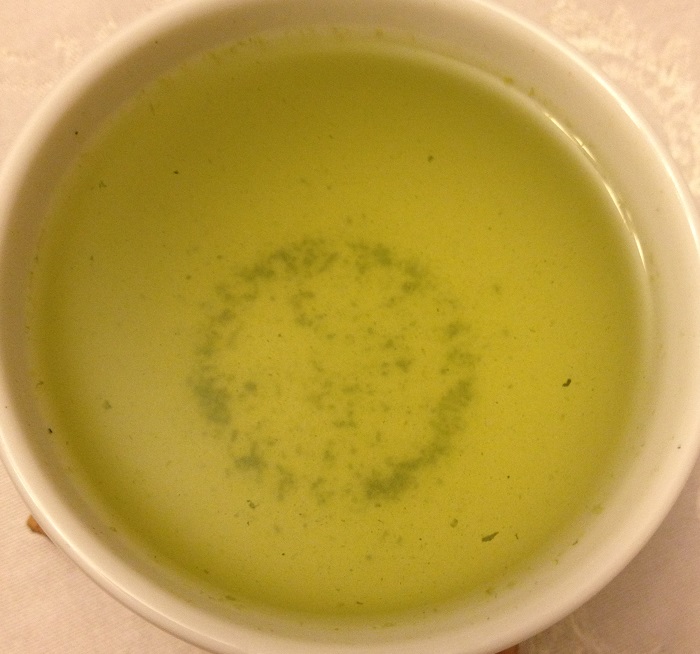Finding pleasure in Japanese green teas is somewhat of a new notion to me. Although I have had various green and black teas from Japan over the years, I cannot say that they were among my preferred varieties. That all changed in one evening about a month or so ago.
My wife was out of town, and I had just put my son to bed. The circumstances were accommodating for a quiet evening. There was no Pittsburgh Penguins hockey games on television, and nothing else that was demanding my immediate attention. Even my three year old Yorkshire Terrier was in a quiet mood. I lit all of the candles in my living room, about eight altogether. I prepared a large bowl of ceremonial grade Matcha, turned off all of the lights in the house, and slowly sipped the jade green elixir in the quiet light of the candles. It was the first time I felt truly relaxed in my own home in quite some time. Americans often forget how beautiful a truly quiet atmosphere can be. I don’t know if it was simply the atmosphere, or my tastes had changed, or a combination of everything, but that Matcha tasted perfect, and had a tranquil and uplifting essence to it. Suddenly, all I was able to think about was Japanese green teas.
Within days, I rediscovered the catalogs of Kyoto Obubu Tea that had been sitting in a file for a few months. I quickly ordered the sample packet, and waited excitedly for it to arrive. When it arrived, it was great to see the array of hoji cha varieties, sencha varieties, and even some interesting products such as the pickled yoshino cherry blossoms. The smoky roast hoji cha was first on my review list, but now it is time for a sencha.
Update 01/09/2014: Simona from Kyoto Obubu Tea sent me some interesting details of this specific Sencha of the Wind. Although the large majority of sencha teas from Japan use the Yabukita cultivar bush, Obubu uses the Zairai cultivar. The Zairai cultivar is known to have larger leaves than the Yabukita, thus explaining my original observations that the leaves of the Sencha of the Wind seemed larger than other sencha products that I have had in the past. Thank you for the information, Simona!
Let the journey begin…

The dry leaves of this Sencha of the Wind are bright to dark green in color, with yellow stems being visible. There is variation in the size of the leaves, which are all fragments. The leaves are tightly rolled. Some of these leaf fragments appear larger than other sencha leaves that I have seen before. However, they do not appear to be fully intact leaves. The leaves are very dry and quite brittle. The aroma is that of fresh grass and sweet hay. The aroma is very fresh and pleasant.
This sample was prepared using the standard method. Filtered tap water was heated to 175°F (80°C). Five grams of dry leaves were placed in an eight ounce (240 ml) kyusu teapot. The leaves were infused for one minute for the first infusion, thirty seconds for the second infusion, and one minute for the third infusion.

The first infusion produced a liquor with a light jade green color. The liquor had a haze to it, and was translucent. The aroma had scents of fresh cut grass, sweet hay, and, although it seems out of place, I thought I detected a slight black pepper scent. The table on which the cup sat was clean, and I do not use black pepper often at home. Anyway, perhaps I misread another scent. The liquor had a medium body, with a savory (umami) feel. The taste had notes of sweet hay, fresh cut grass, and a moderate astringency. The aftertaste was sweet hay, with a lingering flowery essence left on the breath. This first infusion certainly had the umami character that good Japanese green teas are famous for.

The second infusion produced a liquor with darker shade of jade green than the first infusion. The liquor was slightly less hazey. The aroma retain scents of sweet hay and fresh cut grass, and I am still picking up a slight black pepper scent. The body has lightened some, and the savory feel (umami) has also lightened. The taste retains notes of sweet hay, fresh cut grass, and a moderate astringency. The aftertaste has lightened, but the flowery essence on the breath is more noticeable. Besides the lightening in the body and umami, the taste and aroma were nearly as good as the first infusion.

The third infusion produced a liquor with a shade of jade green very similar to the first infusion. Again, the haze in the liquor lightened, but was still present. The aroma retains scents of sweet hay and fresh cut grass, but the black pepper scent has lightened significantly. The body has lightened some again, and the savory (umami) feel has lightened. The taste retains notes of sweet hay and fresh cut grass, and the astringency has leveled off. The aftertaste is light and refreshing, with the pleasant flowery essence retaining its strength.

The infused leaves are a uniform fresh green color, with yellow-green stems. There is variation in the size and shape of the leaf fragments, but I do have to say that these fragments are larger than other varieties of sencha that I have had before. There are no fully intact leaves, all fragments. The leaves are delicate, but I am confident that they can provide one or two additional infusions. The aroma is very fresh, and has a scent of sweet hay and sweet wet grass. The aroma is very pleasant.
I did infuse these leaves two additional times. The fourth infusion was still quite tasteful, but the fifth was rather weak. Regardless, getting four infusions out of a sencha is commendable.
After waiting patiently to have a fresh Japanese green tea, this Sencha of the Wind was quite satisfying. The aroma was very fresh, although the black pepper scent is unexplainable, not that it took anything away from the overall aroma. The taste of the first infusion had the umami feel that truly makes Japanese green teas special. This tea had a very refreshing and hydrating effect to it. I truly enjoyed this tea, and I look forward to having an opportunity to compare two or three sencha varieties side by side in order to understand the more subtle differences between them. Thank you, Kyoto Obubu, for your efforts in producing such teas.
